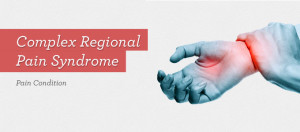 Complex Regional Pain Syndrome (CRPS) is a chronic musculoskeletal pain condition affecting the limbs, hands, and feet, after an injury or limb trauma.
Complex Regional Pain Syndrome (CRPS) is a chronic musculoskeletal pain condition affecting the limbs, hands, and feet, after an injury or limb trauma.
Complex Regional Pain Syndrome (CRPS) is believed to be caused by malfunction of the peripheral and central nervous systems. Individuals have characterized CRPS as prolonged severe pain, changes to the skin, and/or swelling in the affected area.
There are two common forms, CRPS-I and CRPS-II. CRPS-I patients do not have confirmed nerve injury. Patients with CRPS-II have confirmed nerve injuries. Symptoms vary in length and severity. In most cases the disease is mild and individuals recover gradually over time. The more severe cases of Complex Regional Pain Syndrome patients may never recover, and long-term disability can occur. CRPS isn’t caused by psychological factors; the constant pain and reduced quality of life can cause increased depression and anxiety.
Any individual can develop Complex Regional Pain Syndrome. The condition is more prevalent among women; 75% of CRPS patients are women. A majority of individuals develop CRPS in their 30’s- 40’s. In recent years teenagers and pre-teens are developing CRPS at increased rates.
Common Causes and Symptoms of Complex Regional Pain Syndrome
A definitive cause for why some individuals develop Complex Regional Pain Syndrome, while others with similar injuries do not is unknown. In a majority of cases, the condition is triggered by a history of trauma or injury to the arms or legs. Common causes are fractures, sprains/strains, burns, cuts, or bruises. CRPS is an abnormal response magnifying the effects of the original injury. Occasionally CRPS develops without a confirmed nerve injury. The cause may have been an internal injury such as an infection, a blood vessel issue, or entrapment of the nerves; so careful examination is necessary to determine the cause and treat CRPS.
Persistent pain is a key symptom of CRPS, it may be constant, and in some individuals, can become severe. The pain can be described as a burning or “pins and needles” sensations, or as if the arm or leg is being squeezed. Spreading of the pain throughout the affected arm or leg has been reported, as well as to the opposite arm or leg. Complex Regional Pain Syndrome is a systemic disease, and the pain can also spread throughout the body. Often increased sensitivity in the affected arm or leg so even light touch or contact is painful.
Other common symptoms of CRPS:
- Changes in skin texture on the affected arm or leg; it may appear shiny or thin
- Abnormal sweating pattern in the affected arm or leg or surrounding areas
- Changes in nail or hair growth patterns
- Stiffness in the affected arm or leg joints
- Problems coordinating muscle movement; decreased mobility in affected arm or leg
- Abnormal movement in the affected arm or leg; often fixed abnormal posture, but also tremors in the affected area
Common Treatments for Complex Regional Pain Syndrome
Common therapies for individuals with Complex Regional Pain Syndrome often include rehabilitation, psychotherapy, medications, nerve blocks, and spinal cord stimulation. Rehabilitation therapy, or exercise programs to keep the painful arm or leg moving can improve blood flow, improving circulation and reducing inflammation. Rehabilitation can teach the individual new ways to work and perform daily tasks. Psychotherapy is used to help individuals suffering from depression, anxiety, or post-traumatic stress disorder, all of which can enhance the perception of CRPS pain.
Individuals diagnosed with Complex Regional Pain Syndrome may take medication early on, though there is no drug specifically for CRPS. Nerve blocks are often the first step in treatment of Complex Regional Pain Syndrome, but the effects are short term. Another option to reduce pain is to surgically implant Spinal Cord Stimulators in the epidural space near the spinal cord. The stimulator once programmed changes the sensation of pain in Complex Regional Pain Syndrome patients.
There are new emerging treatments for Complex Regional Pain Syndrome patients, intravenous immunoglobulin (IVIG), Ketamine, and hyperbaric oxygen. A study in Great Britain reported low-dose IVIG reduced pain intensity in individuals, who did not respond well to other treatments. An intravenous dose of Ketamine over the course of several days has also been reported to substantially reduce or eliminate chronic pain in CRPS patients. And while still experimental, some studies show hyperbaric oxygen therapy can reduce swelling and pain, and improve mobility in individuals with CRPS.

